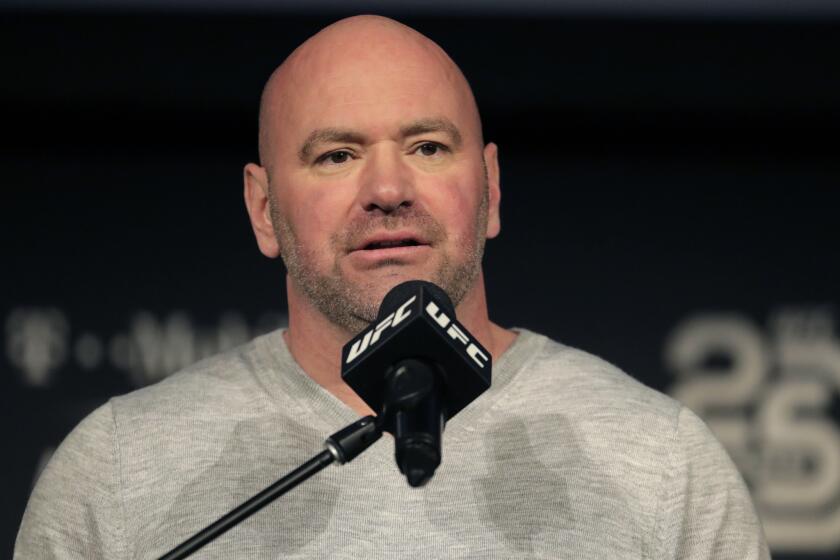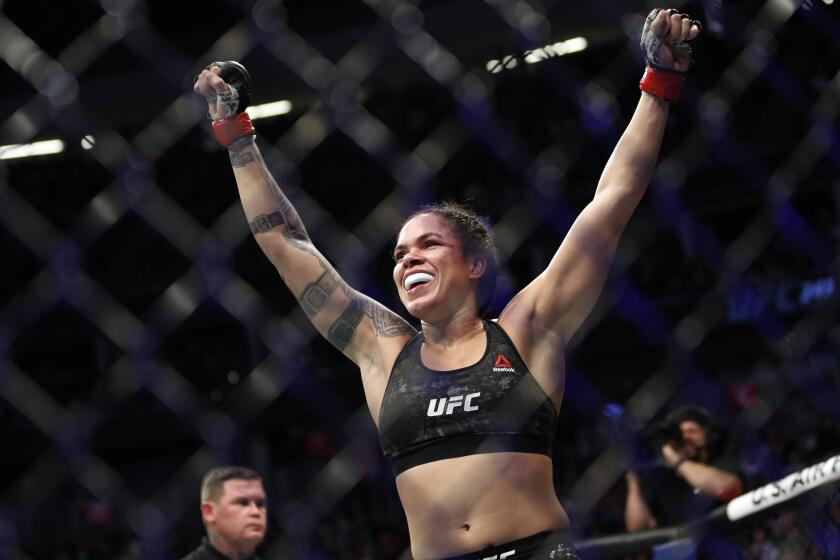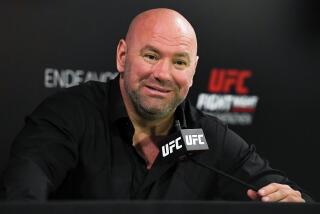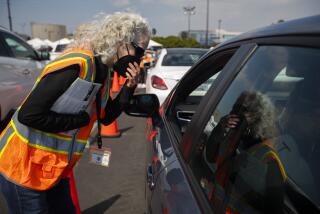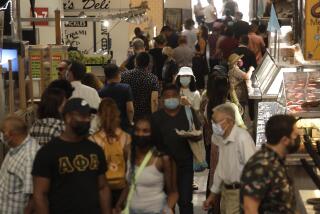Column: Fight night in Vegas is a different experience in the COVID-19 era
- Share via
Las Vegas — The new normal in sports will take some getting used to.
And since there’s a good chance you’re reading this while wearing a mask, near a bottle of hand sanitizer and no one within six feet of you, that shouldn’t come as a surprise.
I experienced the new realities of my job last week before UFC 250 here, in a city that recently reopened its casinos and has welcomed back live combat sports — in fan-free venues — for the first time since March.
About 12 hours before the pay-per-view event was scheduled to begin, I sat in the lobby of a Holiday Inn Express less than two miles northwest of the UFC Apex training center, host of the event. As one of three reporters approved to sit next to the Octagon for the event, I first had to take a COVID-19 test at the hotel and quarantine in a room until the results came back.
The UFC’s mysterious “Fight Island” is actually Yas Island, a popular tourist destination in Abu Dhabi where the MMA promotion will hold four shows in July.
The test was relatively painless. After getting my temperature checked, I was given a COVID-19 throat swab test that took about five seconds. Basically, a big Q-Tip goes down your throat slightly farther than you’d like, causing you to briefly gag, which pretty much signals the end of the test.
The first few hours after the test were fine. I caught up on emails, watched television and finished a salad. Around the fifth hour is when I started to wonder if I had the virus and that’s what was taking so long. I was in Las Vegas, after all. I had checked into my room, walked through a surprisingly crowded casino Friday night and ate dinner at a restaurant that was crowded to near capacity. These previously mundane activities now represented land mines.
I wore a mask, practiced social distancing and felt fine, but what if none of that mattered? My heart began to race as I thought about someone in a hazmat suit knocking on my door and telling me I had COVID-19.
At 2:15 p.m. I was finally told my test was negative and I could return to the lobby to take a shuttle to the nearby training center where UFC 250 was scheduled to take place. For the first time since attending the Lakers-Clippers game on March 8 at Staples Center, I was going to cover a sports event in person.
There were 24 media members credentialed for the event, but only three allowed to sit next to the Octagon inside the training center. The rest watched from inside a tent set up outside the facility, where fighters were taken afterward for news conferences.
Amanda Nunes defended her UFC featherweight title with a unanimous decision over Felicia Spencer. Conor McGregor said on Twitter that he’s retiring.
The UFC Apex is a state-of-the-art, 130,000-square-foot training center and production facility the company built last year adjacent to its headquarters. It is home for all UFC events this month before they move to “Fight Island” on Yas Island in Abu Dhabi next month.
As surreal as it may look and sound to watch live sports on television without fans, it’s even odder in person. You can hear everything, from the fighters heavily breathing, the cornermen barking instructions and the announcers yelling play-by-play and analysis. Everything about the event felt odd, from running into Aljamain Sterling in the bathroom before his first-round submission victory over Cory Sandhagen to writing a story on deadline while wearing a mask and wiping down my laptop with Lysol afterward.
When sports return this summer, they will look and sound different than the games and events you enjoyed pre-pandemic, but that’s OK. We’ll get used to games without fans and teams operating out of neutral-site bubbles, just as we got used to wearing masks and social distancing.
More to Read
Go beyond the scoreboard
Get the latest on L.A.'s teams in the daily Sports Report newsletter.
You may occasionally receive promotional content from the Los Angeles Times.
